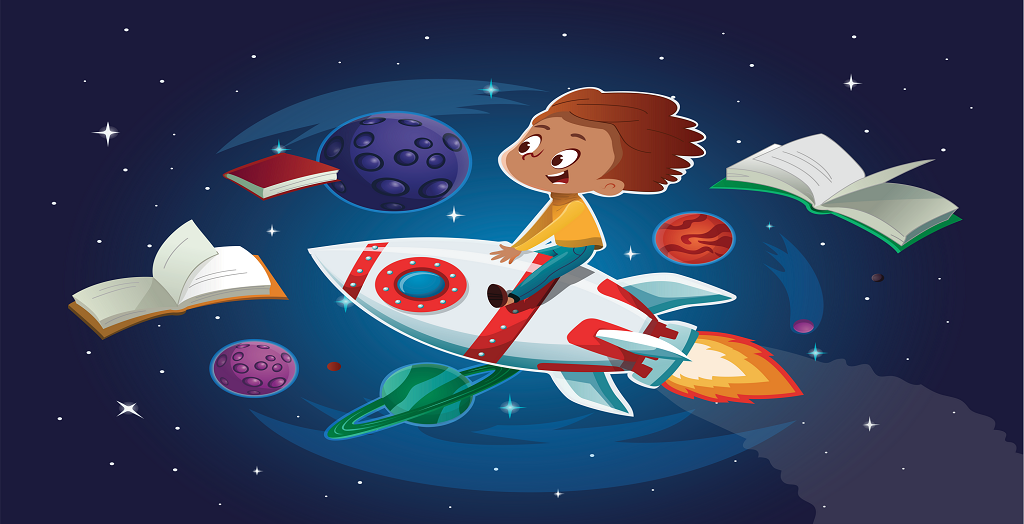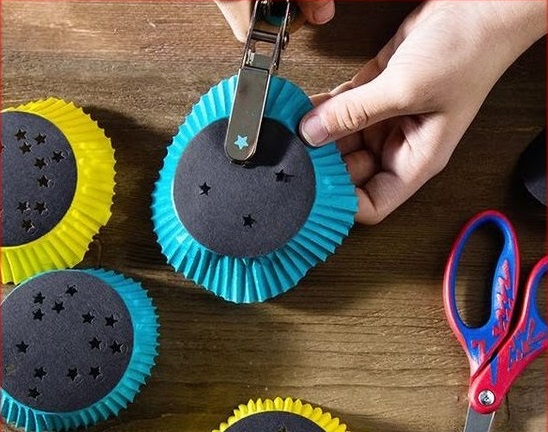It is well worth developing in children that desire to discover everything that surrounds them, both on earth and in heaven. Here you will find the best astronomy activities, experiments and games for children, with constellations, stars, the sun and much more.

What are astronomy experiments for children?
They are all those activities supervised or not, that allow the child to broaden his vision with respect to the universe that surrounds him. They also provide the tools for them to develop meaningful learning about the stars, constellations, and the solar system.
It can be presented in a fun way, relating it to playful activities that include astronomy games for kids and arouse their interest. Knowing and knowing do not detract from the capacity of the children's brain.
Astronomy for children and its benefits
The stage of childhood is the most propitious to develop learning potentialities. The child's cognitive abilities need to satisfy that desire for knowledge of the surrounding environment.
From an early age, through the experiments for preschool, critical thinking can be stimulated in children. What will achieve a better location, in time and space; of its role on the planet and everything outside of its atmosphere.
Astronomical activities for children
Mentioned below are some of the best activities that can be developed by children, both at school and at home. It is only recommended to supervise each of the astronomy experiments for children.
It is important to remember that the necessary clarifications must also be made to each of the questions that arise in the child. It is the only guarantee that learning is really meaningful.
So get to work and best of luck!
Activities to meet the stars
In this section you will find some activities that can be developed, the learning of the celestial bodies, through astronomy experiments for children.
Flashlight to observe the constellations
It is an activity that allows developing the motor skills of infants, as well as being fun. In order to carry out this experiment of observing the constellations children's For ages over 5, the following materials are needed:
- Lantern.
- Batteries or batteries.
- Baking paper molds.
- Colored markers.
- Scissors.
- Garters or elastic band.
The procedure for making constellation models is quite simple. Look for a star pattern, it's simple don't worry! Tell your mom to look on the internet or in an astronomy book, where the stars appear and calculate them.
Now your templates are ready, cut to the size of the bottom of the baking pan. With the white glue, they must paste the template and with the help of a toothpick open a hole in the places where the stars are marked.
The best is yet to come, place your molds on top of the lantern and with the elastic band adjust it so that it does not move. Turn on the flashlight and you can now project your constellations.
The activity should be done in a dark room. They can have competitions of who guesses the most of the names of the stars.
The Star Naming Game
Actually it is not an astronomical experiment per se, but it can be very useful, if you seek to fix the knowledge of the names of the stars for children that in the bosom of their family they are expecting a baby.
It's simple and to enjoy this interesting pastime, you need an illustrated book of the Stars. Search in it, the names of the stars that can fit the newborn if it is a female or a boy.
To make it more fun, make a list of names, cover the eyes of the players and point your finger at random to select the name you would like that baby to have. You'll laugh a lot, cheer up!
Designing a star chart
Do not think that it is something complicated, in fact the map or star chart is like any geography map, only that all the stars of the sky appear in it. It is the astronomy experiment for children, which has a lower degree of complexity.
Being able to design their own star maps makes their work easier when analyzing the sky during a night of observation. With the help of your parents, research in books or the internet, everything you need to draw your star map.
Having your guide map ready, plan an outing to the patio of your house, to a field, the park or, if you like, to the square of your city. There, look at the sky and try to find the stars that appear in your Planisphere guide.
It is an activity that can be carried out periodically and try to determine if the stars have moved from their last observation. They will have something to tell in their next science class at school. You will see that they will shine.
How to have your own nebula at home?
To pull off the following astronomical experiment for kids, they need to be willing to get a little messy and also make a little mess in mom's kitchen.
In order to have your own constellation in your homes, you will have to have the following materials at hand:
- Cotton.
- Water.
- A glass jar.
- Non-toxic ink of different colors.
- Frost or glitter of different colors.
- A wooden pallet.
Steps for the experiment:
It is important that before starting the experiment, they must be under the supervision of an adult and thus avoid accidents.
- Mix the ink of your choice in 50 ml of water and pour it into the glass bottle.
- Dip a piece of cotton in the water with dye and with the help of the wooden paddle, wait until it soaks.
- Sprinkle with glitter or glitter, soaked cotton.
- Prepare another amount of water with a different dye and pour it into the jar, repeat the operation from the previous step.
- All the steps are repeated with the different selected colorants, until reaching the end of the bottle. Cover and our homemade nebula is ready.
For you to have a guide on how to perform this experiment, a video tutorial is presented below.
learning about the sun
It is of vital importance that children develop all their abilities and cognitive skills, through playful pedagogical strategies. The best way to learn is by doing, and if it's fun, even better.
building the solar system
Astronomy for children should be as simple as possible, but without neglecting the fundamental elements. Such as, the order of the planets and the shape of each of them.
The easiest way to learn these planetary aspects is through models or scale models. When children learn through observation, they fixate on learning longer.
The proposed solar system experiment will require the following materials:
- Anime spheres of different sizes.
- Water-based paint.
- Nylon thread or any other thread you have at home.
- Brushes.
- Wipes for cleaning hands.
- An astronomy book, to guide us how to color the anime spheres.
- Metal hook to hang clothes.
- Wooden stick for skewers.
Steps to make the model or mobile:
All proposed activities must be supervised by an adult, to avoid accidents.
- Ask mom or dad to help them find the solar system in the astronomy book or on the internet.
- Paint the anime spheres with the characteristic colors of each planet. Remember to use the size of the spheres that best proportionally represent the real size of the planet to be elaborated.
- Request help so that with the wooden stick, the anime sphere is crossed.
- Thread the string through the hole in the sphere and tie a knot at one end of the string. This must be done with each of the planets.
- Now it's time to place each of the planets on the clothes hanger. For that they are placed starting from the Sun, giving it their location as they appear in the solar system. There will be ropes that are longer than others in order to position them correctly.
We already have our solar system mobile ready. Ask for help to hang it in a high place and ready to continue learning from the Planets of the solar system.
Simulate a lunar eclipse
The Sun affects practically everything that happens in the universe, one of the phenomena where it actively participates is in the lunar eclipses. The eclipse activities children's older than 7 years, is the simulation of the event.
In order to perform this experiment, you will need:
- An anime or wooden base.
- Two spherical objects
- Lantern.
The activity must be directed by an adult who will clarify any doubts that arise, regarding the phases that occur in lunar eclipses.
One of the spheres or any other round object must be placed at the bottom of the base and it will represent the Moon. In front of this object locate the other sphere that will act as planet Earth.
With the help of the flashlight, which will be representing the Sun, set the focus in front of the first circular figure. The light emitted by the flashlight will be the sun's rays and when they are directed directly onto the simulating object to the Earth, it interrupts the reflection of the light.
The lunar eclipse has a total phase and a partial phase. To represent them, it will be necessary to move the object that simulates the Earth so that it partially or completely interrupts the passage of light towards the Moon.
The planets and other things
Our planet Earth is not alone in the universe. Around it there are other planets, stars and constellations that offer a beautiful view day and night.
Keep a record of observations
All research and learning processes require the observation of what is happening around us. It is very important to keep a log of what you see in the sky so that you can understand it more easily.
The experience consists of scheduling, accompanied by an adult, outdoor walks at night, in order to better appreciate the sky. Carrying paper and pencil is very useful, to record all the details that are observed.
Although it may not seem like an experiment, the record is the basis of all future scientific research. That is why the importance of creating the habit of writing and describing the environment.
The incident notebook can include records of eclipses, phases of the Moon, which star or constellation could be identified, among others that will be presented.
Customizing the log book makes it more interesting, put stickers of stars, planets and whatever else comes to mind. In the end, it will remain as a beautiful childhood memory.
Rotatory motion
The planets are constantly moving, they revolve around other stars and they also do it on their own axis as if they were a top. This movement on its own axis is known as rotational movement.
The planet Earth rotates throughout the day and lasts 24 hours. For that reason, it is possible to observe that it goes from day to night.
When the Sun hits one side of the Earth, it is daytime in that area. Therefore, in the other part of the planet it is night, during that time the Earth is dark and it is a little cold, since the Sun's rays do not reach it.
The proposed astronomy experiment for children is the simulation of the movement of Earth's rotation. Its objective is the significant learning of how the planets rotate and the emergence of day and night.
To carry out the project you will need the following materials:
- Wooden stick to prepare skewers.
- anime spheres
- White glue.
- Frost or colored glitter.
- Brushes.
Steps to develop the experiment:
- With the help of the wooden stick, a hole must be opened in the anime sphere, going from end to end.
- Dilute in two parts of water, one part of white glue. With the brush cover the entire sphere, with the glue mixture, spread the glitter and let dry.
- To check the rotational movement, take one end of the remaining wooden stick and rotate it on a flat surface.
The reasoning of the experiment is, just as that anime sphere rotates on this end of the wooden stick. In the same way the planets rotate on their own axis.
Crater Maker
Craters are formations that occur in the relief, the product of strong meteorite impacts. They are usually found on planets, asteroids or natural satellites.
The proposed experiment consists of placing enough flour in a rectangular tray approximately 5 centimeters high to reach the top of the tray.
Collect marbles of different diameters and weights. The experiment is quite fun, but remember to ask an adult to accompany you and have your parents' permission. Since the disaster that will be armed will be quite considerable.
In order to be able to throw the marbles and produce the desired effect, they must be placed at a considerable height from the tray. The marbles are dropped one by one and then the deformations suffered in the flour surface can be observed.
The craters of greater depth and diameter correspond to the marbles of greater weight and size. While the shallower ones will be those smaller and lighter marbles.





